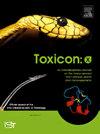Biochemical characterization of the venom of the Bolivian endemic pit viper Bothrops sanctaecrucis
IF 2.8
Q2 TOXICOLOGY
引用次数: 0
Abstract
Ophidic accidents are an important public health problem in South America, specifically those related to the Bothrops genus, due to their high incidence, complexity and severity of envenomation symptoms. The species B. sanctaecrucis, the only one from this genus endemic to Bolivia, is the most frequently found and involved in snakebites in the Chapare region of Cochabamba; however, its toxicological implications on human health are poorly known. Herein we conducted the first biochemical characterization of its venom. Its electrophoretic profile showed components mainly ranging from ∼10 to 37 kDa, resembling other Bothrops venoms. The venom exhibited high activity on azocasein (47.65 U/mg) and the thrombin-specific substrate S-2238 (625.55 μmol/min/mg), and noticeably hydrolyzed gelatin and human fibrin(ogen). The venom also degraded lecithin and hyaluronic acid, but both at low levels. These in vitro results point out a toxic mechanism of action fundamentally at a local level, with tissue damage likely caused (although not exclusively) by SVMPs. Immunochemical reactivity was evaluated against Bothrops antivenoms produced in Argentina, which not only exhibited cross-reaction by Western Blotting but also neutralized the procoagulant activity of the venom. This study offers first insights into the venom components of B. sanctaecrucis, and provides preliminary and important information about the pathophysiological mechanisms involved in the envenomation by this species, paving the way for treatment strategies in such accidents.

玻利维亚特有毒蛇Bothrops sanctaecrucis毒液的生化特征
在南美洲,毒蛇事故是一个重要的公共卫生问题,特别是那些与Bothrops属有关的事故,因为它们的发病率高、中毒症状复杂且严重。玻利维亚唯一的一种这种属的特有物种,在科恰班巴的查帕雷地区最常被发现并参与蛇咬伤;然而,人们对其对人类健康的毒理学影响知之甚少。在这里,我们对其毒液进行了第一次生化表征。其电泳图谱显示其成分主要在~ 10 ~ 37kda之间,与其他Bothrops毒液相似。该毒液对偶氮酪蛋白(47.65 U/mg)和凝血酶特异性底物S-2238 (625.55 μmol/min/mg)具有较高的活性,对明胶和人纤维蛋白(原)具有明显的水解活性。这种毒液也能降解卵磷脂和透明质酸,但含量都很低。这些体外实验结果指出了一种从根本上在局部水平上起作用的毒性机制,svmp可能引起(尽管不是全部)组织损伤。阿根廷产的Bothrops抗蛇毒血清不仅表现出交叉反应,而且还中和了蛇毒的促凝活性。本研究首次揭示了sanctaecrucis的毒液成分,并为该物种中毒的病理生理机制提供了初步的重要信息,为此类事故的治疗策略铺平了道路。
本文章由计算机程序翻译,如有差异,请以英文原文为准。
求助全文
约1分钟内获得全文
求助全文
来源期刊

Toxicon: X
Pharmacology, Toxicology and Pharmaceutics-Toxicology
CiteScore
6.50
自引率
0.00%
发文量
33
审稿时长
14 weeks
 求助内容:
求助内容: 应助结果提醒方式:
应助结果提醒方式:


